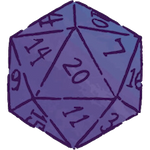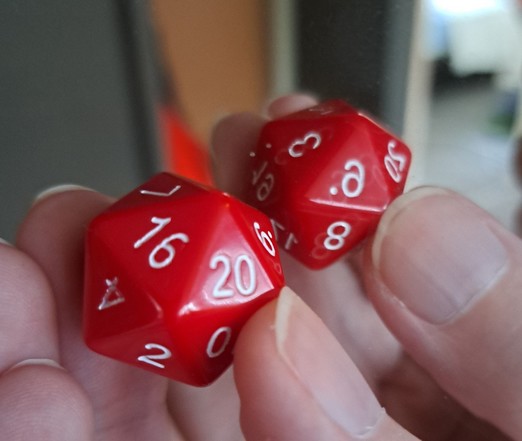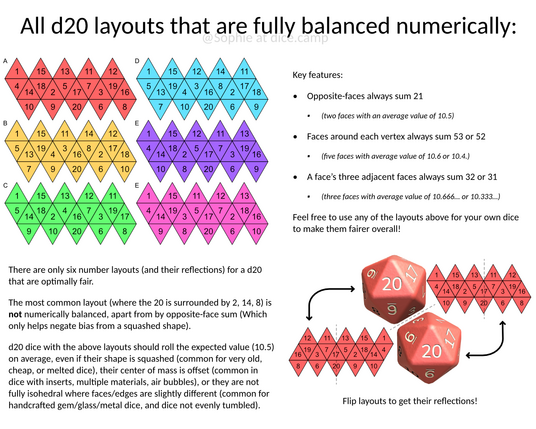I've been meaning to make an updated version of this for a while so here it is, every numerically-balanced d20 layout!
Feel free to share, especially with any dice makers you think may be interested!
There is a more detailed explanation video by @henryseg for The Dice Lab (which use layout C, if you're curious!) https://youtu.be/Nh2H_4g6evc
Some additional notes if anyone is curious:
I've also seen layout C on Role 4 Initiative dice (I fully recommend their sets with larger numbers and the 'arch d4's)
I know these are all the numerically balanced layouts because I ran an exhaustive computer search a few years ago. If your d20 doesn't match a layout above, it's not fully numerically balanced.
A die without this kind of layout isn't necessarily unfair! A perfectly formed d20 would be fair whichever faces the 1 to 20 numbers are on
And a key point I think is very important (and you're welcome to relay it to your DM if they get mad at you for dice that aren't numerically balanced or are even spindown/counter dice):
Dice don't usually need to be so fair! In most cases it is fine so long as they are fair *enough*.
Especially with RPGs, the point isn't perfectly balanced competition, the point is to have fun and come up with a good story. Almost any die is good for that!
additional (absurdly nerdy and pedantic) point:
These layouts keep biased dice more fair by having their average rolls be as close to the expected value as possible.
A fair d20 rolls 10.5 on average, a biased d20 with these layouts rolls 10.5 on average (unless the bias is HUGE)
But that doesn't mean the biased die is now equally likely to get any number from 1-20, it still lands on some faces more often, those faces are just less likely to be always a help or a hinderance.
And depending on the game system you are using, the biased die may still be more likely to give positive or negative results, especially if it has many re-rolls, discarded values, or non-numerical meanings that aren't balanced (eg, four crit successes with only one crit fail - the system itself is skewed but a biased die could skew it more/less for an individual player)
Before I forget, reflected layouts are the same but mirrored in 3D (you can't just flip the 2D net!).
So layout R(C) is what you would see if looking at layout C in a mirror, which I have a photo of!
(the reflection has R(C) layout, but obviously the labels also appear flipped, because, mirror)
hmmm, maybe you *can* just flip the 2D net now that I think about it. It wouldn't look the same as above but it would make a rotation of the reflected layout... I think?
tbh I'm starting to get tired and don't want to share misinfo so I'll stop adding to this thread here. Everything but this point I'm super confident about though.

okay, awake Sophie is thinking clearly, you CAN just flip the net to get a reflected layout.
I've made a new image to be clearer about this (the original is still not wrong, it's just that the reflected nets shown are also rotated - which makes no difference to the layout but is an unnecessary complication for understanding)
@Sophie that was one thing that I took from a talk at the roguelike conf: not all randomness is fun! I feel bad for my players when they’ve had a bunch of low rolls in a session. I fudge a bit on the DM side and only keep approximate track of eg monster health so I can be like “oh, yeah, that hit ended the monster, tell me how your character finishes it off” even if really it would have taken a couple more turns. I also give partial success for lower rolls on some ability checks. Helps move the game along, though I get that some players want max accuracy.
@Sophie recently saw a clip about the usefulness of "emphasis dice" - you replace 18 and 19 with 20s, but also replace 2 and 3 with 1s. They were saying that more frequent critical successes and fails can be a fun way to add tension to extra impactful moments.
Unfortunately I only listen to TTRPG content and don't have a group (yet) so I'm curious what you think of that!
@fletchmakesstuff I think that is cool tbh! It might make some things a little less "crunchy" which might disappoint some players, but if the group is happy with it then it's a great tool to have in the pocket. (Though I am also a person who doesn't play often these days, so, grain of salt!)
@Sophie Flipping is the same as mirroring.
@Sophie Video game where you use dice. All the dice have specific biases you can figure out over time. You can buy and trade dice to optimize your build.
@Sophie I've stared at this long enough and rotated enough shapes in my head to convince myself that:
any mirroring of C produces R(C). It's 'upside-down' but the 1-5-14-18-15 corner is preserved
whether that rolls fairly is going to come down to number etching divot depth



